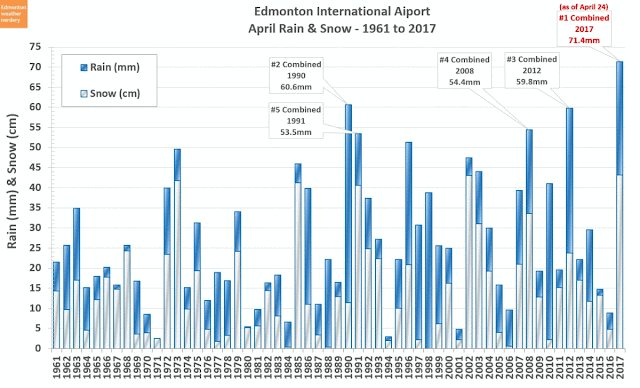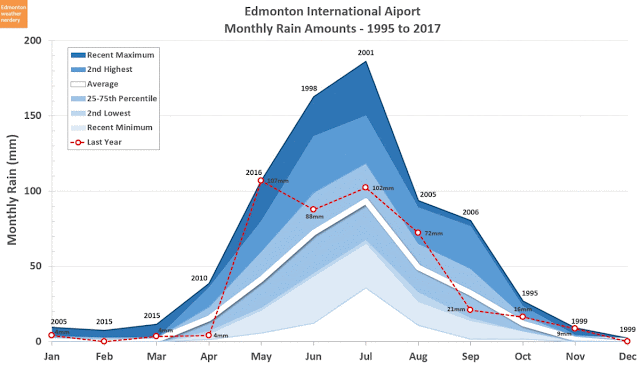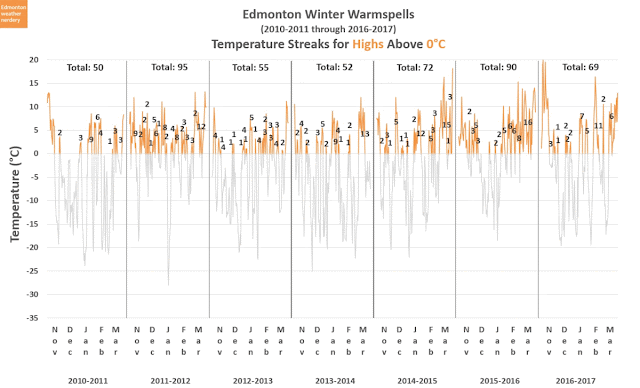Today we're going to look back at the winter of 2016-2017 again, this time to see how things compared between Edmonton and Calgary. This is a battle-of-Alberta that Edmonton will never win, but it's something I'm always curious about.
We've looked at Calgary weather
plenty of times before, but that has been averages and trends, where today will be more of a day-by-day comparison.
This will also be focusing on November-through-March, even though as I write this in mid-April Edmonton is in the midst of
Winter Part 2: The Revenge while Calgary and everywhere else have moved on to spring. But anyway...
High Temperatures
Here are the daytime High temperatures for Edmonton and Calgary, for this past winter from November through March. There were 96 days when Calgary was warmer than Edmonton, and 49 when Edmonton was warmer.
The fact that Calgary is generally warmer than Edmonton should not come as a surprise. But what I do think is interesting, is just how closely the temperatures track one another. We can see here that the temperatures in Edmonton and Calgary followed the same rollercoaster - albeit with Edmonton shifted down a few degrees on some days.
We've talked a lot about
chinooks in the past, and this winter almost everytime that Calgary broke above the freezing mark Edmonton did too. The only time that Edmonton went one way and Calgary the other was in late November, when Edmonton was around freezing but Calgary jumped up to 10°C.
(although it's also happening right now in mid-April)
With this chart it's tough to get a sense of how the gaps compare, so next we'll take a look at the actual temperature differences.
High Temperature Differences
Here we have the difference in daily High temperature for Edmonton and Calgary.
In this chart the orange days (on the positive side of things) are when Edmonton was warmer, and the red (into the negative) are when Calgary was. When Edmonton was warmer it was usually only by a few degrees, but when Calgary was warmer in some cases it was by 5°C-15°C.
Breaking it down by month:
- At the end of November we can see that two-week stretch where Calgary was 5°C-10°C warmer than Edmonton.
- In December things were fairly balanced
- For January Calgary was solidly warmer
- In February Edmonton actually spent a good portion of the month warmer than Calgary
- And to end off, in late-March Calgary warmed up to spring-like temperatures a few days faster than Edmonton did.
Here we have the same chart, but this time it shows the average temperature difference, as well as the 10 biggest differences.
The average difference varies throughout the winter. For December and February it hovered around 0°C, and even crept onto the Edmonton side of things at the end of February. In early November and January Calgary averaged about 3°C warmer. And in late-November and late-March Calgary averaged 5°C warmer.
The largest gap was 15°C on March 13, with Calgary at 9°C and -6°C Edmonton, as Calgary recovered from the mid-March deepfreeze much more quickly than Edmonton did. And we can see that the really large 10°C-15°C gaps usually only happen one day at a time. Calgary isn't 10°C warmer for a whole week, but it is 10°C warmer the day that a chinook moves in, and then Edmonton usually catches up a bit the next day
(although mid-April is going to make a liar of me).
In total, there were 6 days when Calgary was 10°C or more warmer than Edmonton, and 30 when it was 5°C or more warmer. On the flipside, Edmonton was 5°C warmer than Calgary only once, on February 27.
Low Temperatures
Here we have the daily Low temperatures for Edmonton and Calgary, and here things are a little bit more balanced than what we saw for the Highs. This winter there were 79 nights when Calgary was warmer than Edmonton, and 76 when Edmonton was warmer.
And again, the temperatures in Edmonton and Calgary follow a very similar path.
Lets take a closer look at the temperature differences again:
Low Temperature Differences
Here we have the difference in Low temperatures for Edmonton and Calgary. Days where Edmonton was warmer show up on the positive side in blue, and warmer Calgary days are into the negative in red.
Breaking it down by month again:
- For November Edmonton's overnight lows were pretty consistently warmer than Calgary's
- December was balanced between the two cities
- January's lows in Calgary were generally warmer than Edmonton's
- And them February and March were a mix
Here we have the 7-day average difference, as well as the 10 largest differences.
The average difference varies from about 3°C warmer for Edmonton to about 3°C warmer for Calgary. As we saw with the last chart, Edmonton was warmer in November and Calgary was warmer in January, but the other months are more of a mix.
The two largest gaps were 9°C: on February 8 Edmonton dropped to -21°C while Calgary fell to -30°C; and on March 14 Calgary warmed up to -1°C while Edmonton was stuck down at -10°C. The rest of the top 10 are split between Edmonton and Calgary, and range between 5°C-8°C difference.
Temperature Breakdown
Finally, here are how the High temperatures add up for the two cities.
For November through March Calgary had 2 more days between 20°C-25°C, 2 more between 15°C-20°C, 8 more between 10°C-15°C and 4 more between 5°C-10°C.
That's a total of 16 more days above 0°C for Calgary, with Calgary breaking above freezing on 85-of-151 days, and Edmonton managing 69-of-151.
For the Low temperatures things are pretty similar between the two cities. Edmonton had 3 more nights above freezing than Calgary did, and Calgary had one extra night below -25°C. Although this is with the caveat that we're comparing Edmonton Blatchford to the Calgary International, which is something that
we've looked at in great detail before.
Snowy Months
Temperatures are only part of the story of winter though, so now we're going to switch over to snow to finish things off for the day:
When we look at the monthly snowfall totals, we can see that monthly average for October through February are pretty similar for Edmonton and Calgary. But Calgary's spring tends to be snowier, with higher averages in March, April and May.
2016-2017 was a little bit more complicated than that, though. We had about 10cm more snow than Calgary in both October and November, but then Calgary had 10cm more in December. January was pretty similar for the two cities. Then Calgary had a very snowy February with 36cm compared to our 9cm. Then in March we had about 10cm more again. And now, as of mid-April we're well above our average for the month, and Calgary is still below theirs.
Cumulative Snow
When we add all of that up over the course of the winter, this is where we end up.
For the early part of the winter Calgary was below Edmonton, but their snowy December pushed us into a tie, and then their very snowy February put them in the lead. But all of the snow that Edmonton just received at the start of April pushed our cumulative total up 124cm, and just a little bit above Calgary's at 120cm. Going back to the averages again, between now and June Calgary would typically get more snow than we would, but looking at the current forecast for Edmonton, who knows?
Conclusion
So today was another marathon. But now we've really dissected one specific winter, instead of always looking at averages. This wasn't necessarily a "typical" winter, although I'm not sure that any are? But it's interesting to see how closely the temperatures tracked, what the temperature jumps from chinooks really look like, and how much the snow can vary between the cities.





















































